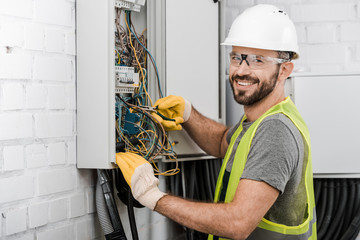The electrician will prepare, install, test, troubleshoot, and repair electrical wiring, fixtures, control devices, and other equipment in all types of buildings. They may work for building maintenance departments or as self-employed electricians.

A career as an electrician can be rewarding, but you must be willing to put in the time and effort. Becoming a licensed electrician takes years of training, and you may spend a lot of time working on jobs that others won’t do.
A professional electrician can install new electrical wiring in your home to connect the outlets, switches and lights. They will follow local and national building codes to ensure the job meets all requirements for safety. The process can be expensive, but it is necessary for a safe home.
Replacing old wiring is an important part of upgrading a home’s electrical system, especially for older homes. Unless you are a skilled electrician, it’s best to leave the work to professionals who have extensive experience with rewiring historic buildings.
The cost to rewire an existing home will depend on the number of wires that need to be replaced, as well as the labor involved. Electricians may need to remove old wires from attics, basements and crawl spaces before installing new ones.
They’ll also need to open up walls or ceilings in order to reach the wires inside the home. This is not an easy task, especially for rewiring old homes with plaster walls and ceilings.
Once the old wires have been removed, you’ll need to replace them with new, insulated wire. You can purchase a variety of gauges of cable from an electrician or at your local hardware store.
Before beginning the installation, be sure to turn off the power at the breaker box and test any new wires with a voltage tester. This will help you determine if there are any issues with the old wiring.
You’ll want to remove old splices or connections, such as those with metal wire, if they are exposed. These can lead to short circuits, which are dangerous to live electrical systems and can cause serious damage to your home.
When replacing the splices, make sure to use the correct wire size for your house. You’ll also want to be sure that the ground wire is connected to the neutral wire before reattaching it to the receptacle box.
The best way to find an electrician to complete your rewiring project is to shop around and compare quotes. Look for companies with an established track record of rewiring homes, and be sure to read reviews and ratings posted by previous customers.
Troubleshooting electrical issues is the process by which electricians determine why a component in your home isn’t working. They’ll check for faulty connections, burnt-out light bulbs, and open circuits in the wiring.
Once they’ve determined what the problem is, they can fix it by either repairing or replacing the component. In some cases, a problem may be so severe that they will need to replace the entire unit.
They will also check for overheating issues in the wires and equipment. This is because if the wires are hot, they’ll be dangerous to touch. In addition, they’ll likely cause sparks, which could ignite fires.
The most common types of electrical faults are open circuits and short circuits. These are the most straightforward to troubleshoot, as they occur when a component in the circuit isn’t getting enough voltage to operate correctly.
Another type of electrical fault is a backstabbed wire. This is when the insulation around a conductor has worn down and exposed live wiring. This is dangerous and should be fixed by an electrician.
Occasionally, you’ll notice that the power in your house goes out or fades for a moment before coming back on. This is known as a surge, and it can damage the wiring in your home and electronics on the grid.
This is because the power isn’t running through the right parts of your grid. The best way to prevent this is to keep your fuses and circuit breakers in good working order.
In addition, you can try to reduce the amount of power that’s being used in your home by unplugging appliances and using lower settings on certain devices. This may reduce your power bill and help you avoid costly repairs down the road.
A tripped circuit breaker can be caused by many things, but it usually has to do with the appliance that is tripping it. This may happen because of overheating, a loose wire, or a damaged switch.
A short circuit can also cause a fuse or circuit breaker to trip. This is more difficult to diagnose and repair, as the tripped circuit breaker can be a symptom of an open short circuit in the wires.
An upgrade to 100-amp service means replacing your current electrical panel with one that can handle the power needs of your home. It involves replacing your breaker panel, circuit breakers, meter socket, service conductors, grounding electrodes and bonding conductors. This work is typically done by a licensed electrician.
The cost to upgrade your service depends on a number of factors, including the size of the panel and how many circuits it can handle. It also depends on the type of wiring that is used and the level of work required.
Upgrading from a 100-amp panel to a 200-amp service will usually require an electrician to replace your current wiring and install a new electrical panel. This process can be time-consuming, especially if your wiring is old or in poor condition.
Rather than upgrading your entire panel, it may be cheaper and less stressful to simply add an extra circuit to your existing panel. This will save you money in the long run and ensure that your home’s electrical system is able to keep up with your household’s power demands.
In addition to saving you money, adding an extra circuit will allow your appliances to run more efficiently and safely. Moreover, it will help to prevent problems with your current wiring and fuses in the future.
A 100-amp electrical service is the bare minimum for most modern homes. This capacity will allow you to use a wide range of electrical devices and appliances without worrying about overloading or damaging them.
Most homeowners, however, need a more powerful panel to handle their specific electricity needs. This is particularly true if you have a large, luxury home or run a business that uses specialized equipment.
The most common electrical service sizes are 60, 100, 150, 200 and 400 amps. The larger the amperage, the more expensive it is to install.
Most older homes have circuit breaker panels with 60-amp service, which aren’t enough to handle the power needs of most homes. In fact, this kind of panel is considered outdated and poses a fire risk. In order to make sure your home is safe, it’s important to have a newer panel installed with circuit breakers that are designed to protect your wiring from overheating and overloading.
Maintaining electrical systems is an important part of keeping your home safe and working correctly. It involves inspecting, testing, and repairing any electrical equipment to make sure it remains in good working condition. It is typically done by electricians and maintenance personnel who are trained in the process and follow safety rules.
When you call an electrician for maintenance, they will take the time to look at all of the different parts of your electrical system. This includes checking the breakers and outlets to make sure they are properly connected and safe to use. They will also clean your breakers and outlets to make them work more efficiently.
It is also a good idea to have the electrician add secure safety settings to any circuits in your house. This will help to prevent any potential accidents or injuries from occurring. If you have children or pets, this is a great way to keep them safe while you are away.
In addition to protecting you and your family, keeping your electrical system in tip-top shape can also save you money. Having routine electrical maintenance can reduce your energy costs and keep you and your appliances running smoothly for years to come.
Having your electrical system inspected and maintained regularly can also help you to detect any problems that aren’t immediately noticeable. For instance, if you have a circuit that doesn’t work as it should, it may be time to replace it with a new one.
The electrician will also check to see if your home has any hazardous areas that need to be protected. This could be areas where a lot of water is present, such as a laundry room or bathroom. You will also want to make sure that your outlets are above the water level.
Your electrical system is vital to your business, so it’s important to have it properly maintained. Not only will this ensure the safety of all those who work there, but it can also minimize downtime and prevent interruptions to your business operations.


